Riya Patel
AP Art History 🖼
34 resourcesSee Units
Catacomb of Priscilla
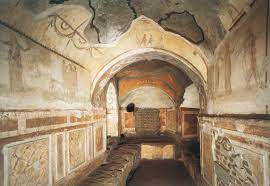
Courtesy of Web Gallery of Art
Form: The Catacomb of Priscilla is a network of underground burial tunnels dating back to the 2nd century AD. It is notable for its well-preserved frescoes, which were painted in the Pompeiian style and depict scenes from the Bible and early Christian martyrs. The catacombs are located in Rome and are open to visitors.
Function: Early Christians used catacombs as underground burial places. The Catacomb of Priscilla is one of several such catacombs in Rome, and is believed to contain the remains of around 40 thousand people, including several popes and early Christian martyrs. These catacombs served as an important place for the early Christian community, as well as a symbol of their faith and a place for worship. They are now open to visitors as an important historical site.
Content: The Catacomb of Priscilla contains a variety of frescoes and other artwork depicting scenes from the Bible and early Christian martyrs. The image of Jesus as a shepherd is a common theme in early Christian art, as it represents his role as a protector and guide for his followers. The use of imagery from the Old Testament, such as the depiction of Jonah, is also common as it serves to link the teachings of the Old Testament with those of the New Testament and demonstrate how early Christians saw Jesus as the fulfillment of Hebrew scripture. Additionally, the presence of symbols such as doves, peacocks, and pheasants can represent the Christian belief in immortality and the afterlife. The Greek chapel is so named because of the presence of Greek inscriptions on the walls, which is also a common characteristic of early Christian art.
Context: The image of the Good Shepherd and its symbolism is prominent in Christian theology and art. The image of Jesus as a sympathetic and caring shepherd who guides his followers is meant to convey his role as a protector and guide for his followers. The Orant fresco is one of the frescoes found in the Catacomb of Priscilla, it depicts a figure with arms outstretched and eyes gazing towards the heavens, it is believed to be a representation of a Christian praying. This posture of Orant, also known as the "orans" (orante in Italian) is typically associated with early Christian art and was adopted from the pagan tradition, where the Orant figure was used as a symbol of the soul. The Orant fresco could also be a representation of a woman who has progressed through the three stages of life and is now in the afterlife.
Santa Sabina
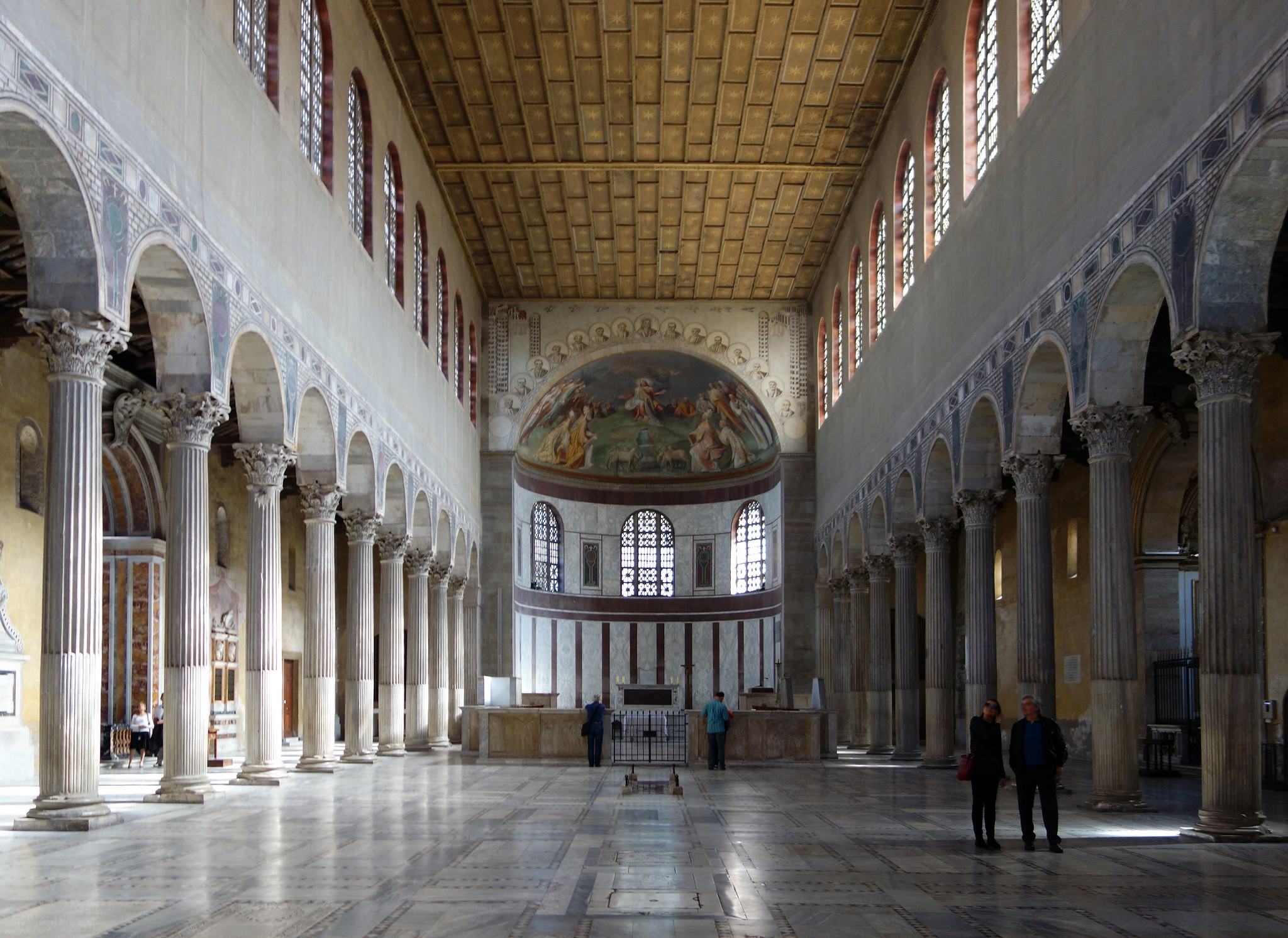
Courtesy of SmartHistory
Santa Sabina is a church located in Rome, Italy, it is an example of the early Christian basilica architecture, which was used for many churches built in the 4th and 5th centuries. Santa Sabina is a three-aisled basilica, with no transept, meaning it has a long central nave and two side aisles. It is built on an axial plan, with the entire focus of the church on the apse, which is typically where the altar would be located. The church had a flat roof with a coffered ceiling and thin walls, and the plain exterior was designed to contrast with the beautiful interior. The basilica of Santa Sabina is considered one of the best preserved and most important examples of early Christian architecture and is still open for visitors.
Form: The three aisles, long tall nave, and the axial plan with the apse as the focal point are typical features of the basilica. Additionally, having a flat roof with a coffered ceiling, and thin walls is also characteristic of the basilica's architecture. The plain exterior of the basilica is a design feature, which was intended to contrast with the ornate decoration of the interior.
Function: Place of Christian Worship - Religious
Context: The church of Santa Sabina in Rome, Italy is believed to have been built on the site of early Imperial houses, one of which is said to be the home of a Roman matron named Sabina. According to tradition, Sabina was a resident of the area and converted to Christianity by her servant Seraphia. She was then beheaded under the Emperor Vespasian or perhaps Hadrian because of her faith. After her death, Sabina was declared a Christian saint. The church of Santa Sabina is believed to have been built over her home as a tribute to her and as a place of worship for the Christian community in the area. The church today is considered an important example of early Christian architecture and still stands as a place of worship and a historical site.
Rebecca and Eliezer at the Well and Jacob Wrestling the Angel
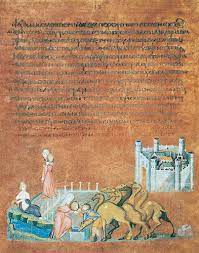
Courtesy of Khan Academy
Form: It is likely that the artist used classical techniques such as contrapposto, foreshortening, shading, and perspective in illustrating "Rebecca and Eliezer at the Well" and "Jacob Wrestling the Angel." Contrapposto is a technique in which the human figure is posed with most of its weight on one foot, creating a more natural and dynamic posture. Foreshortening is a technique used to create the illusion of depth by shortening parts of the figure that are closer to the viewer. Shading is used to create the illusion of three-dimensionality and to indicate the direction of light. Perspective is used to create the illusion of depth and distance in the setting. The settings are shallow and organized in the lower portion of the page with Greek text above; it's possible that these illustrations are part of a manuscript or fresco and the Greek text above them may be inscriptions or captions. The use of Greek text in Christian art is not uncommon as Greek was a widely spoken language during the early Christian period.
Function: The possession of manuscripts, especially those with intricate illuminations like the Vienna Genesis, was a status symbol in the medieval period. These manuscript illuminations were created by skilled artists, and the process of creating them was time-consuming and expensive. The use of these illuminations in manuscripts was not only for decorative purposes but also served a didactic function, helping to illustrate the stories and teachings of the faith. Christianity relied heavily on text to establish the details of belief and set standards of conduct for its members. Therefore, it was essential for many wealthy Christians to own and display copies of scripture as a way of demonstrating their devotion and piety. The Vienna Genesis, in particular, is a luxury item, and it is not known for certain whether it was intended for display or for private reading. However, it is likely that it served both purposes, providing a synopsis of exciting stories from scripture for edification or diversion for the wealthy Christian, and also for display as a status symbol.
Content: The Vienna Genesis is the oldest book of its kind. An illustrated manuscript produced in Syria and held in Vienna, the Vienna Genesis contains twenty-four folios, of which "Rebecca and Eliezer at the Well" and "Jacob Wrestling an Angel" are just two. During the fourth and fifth centuries, a Greek translation of the Bible known as the Septuagint was the most popular form of the Christian scriptures. In addition to this written Biblical account, the Vienna Genesis uses images to help convey meaning.
Context: The Vienna Genesis is a significant artifact of early Christianity and a valuable example of early Christian art. The use of images to supplement the written text demonstrates the importance of visual storytelling in the transmission of religious beliefs. The illustrations in the Vienna Genesis were likely created by skilled artists who used classical techniques to create detailed and expressive images. The manuscript likely would have been commissioned by a wealthy patron and would have been used for religious education and devotion. The Vienna Genesis is a valuable resource for scholars studying the history of Christianity and the development of early Christian art.
Hagia Sophia
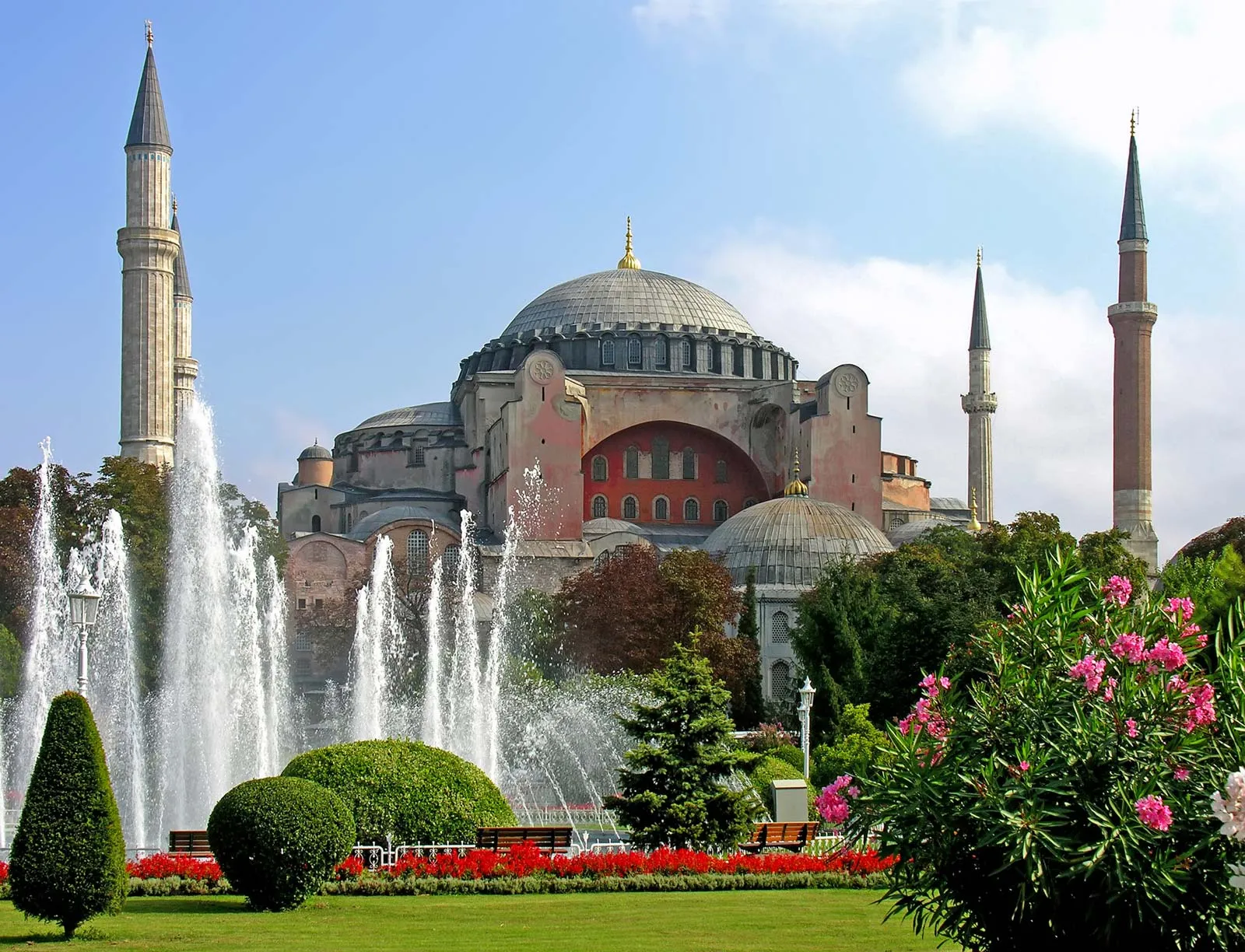
Courtesy of Encyclopedia Britannica
Form: Hagia Sophia is a Byzantine architectural masterpiece built in the 6th century in Istanbul, Turkey. It was originally built as a cathedral and later converted into a mosque before being converted into a museum. The building's design was revolutionary for its time, as it combined the traditional basilica plan with a massive central dome. The dome is considered one of the greatest architectural achievements of the Byzantine era. The building's interior is adorned with intricate mosaics and marble decoration, including a large mosaic of Christ Pantocrator above the central dome. The building is a UNESCO World Heritage Site and is a popular tourist destination.
Function: Hagia Sophia is a historic structure that has served different religious and cultural purposes throughout its history. Originally built as a Byzantine cathedral in the 6th century AD, it served as the main church of Eastern Orthodox Christianity for nearly a thousand years. After the Ottoman Empire conquered Constantinople in 1453, it was converted into a mosque. In 1935, it was converted into a museum, and it has continued to function as such to this day. In 2020, the Turkish government converted Hagia Sophia into a mosque once again.
Content: One notable mosaic from the tenth century depicts Mary and the baby Jesus. The couple is flanked by two men in the image: Emperor Constantius, son of Constantine, and Emperor Justinian, who oversaw the church's largest reconstruction in the fifth century. The entire surface is decorated in gold, with the figures standing in the center. The two emperors appear to be identical, with the same hairstyle and outfit, and both holding maquettes, or scale models, of buildings. Constantius is holding a maquette of Constantinople, while Justinian is holding a maquette of the Hagia Sophia itself.
Context: A pagan temple once stood on the site where Hagia Sophia now stands. However, in 360, the site was taken over by Christians, who built a small basilica where the temple had once stood. The structure was destroyed and rebuilt numerous times over the next two centuries. It was a contentious site for Muslims and Christians alike, as well as local iconoclasts who destroyed many of the opulent mosaics. When the Ottoman Turks conquered Constantinople in 1453, the building was converted into a mosque.
Virgin (Theotokos) and Child between Saints Theodore and George
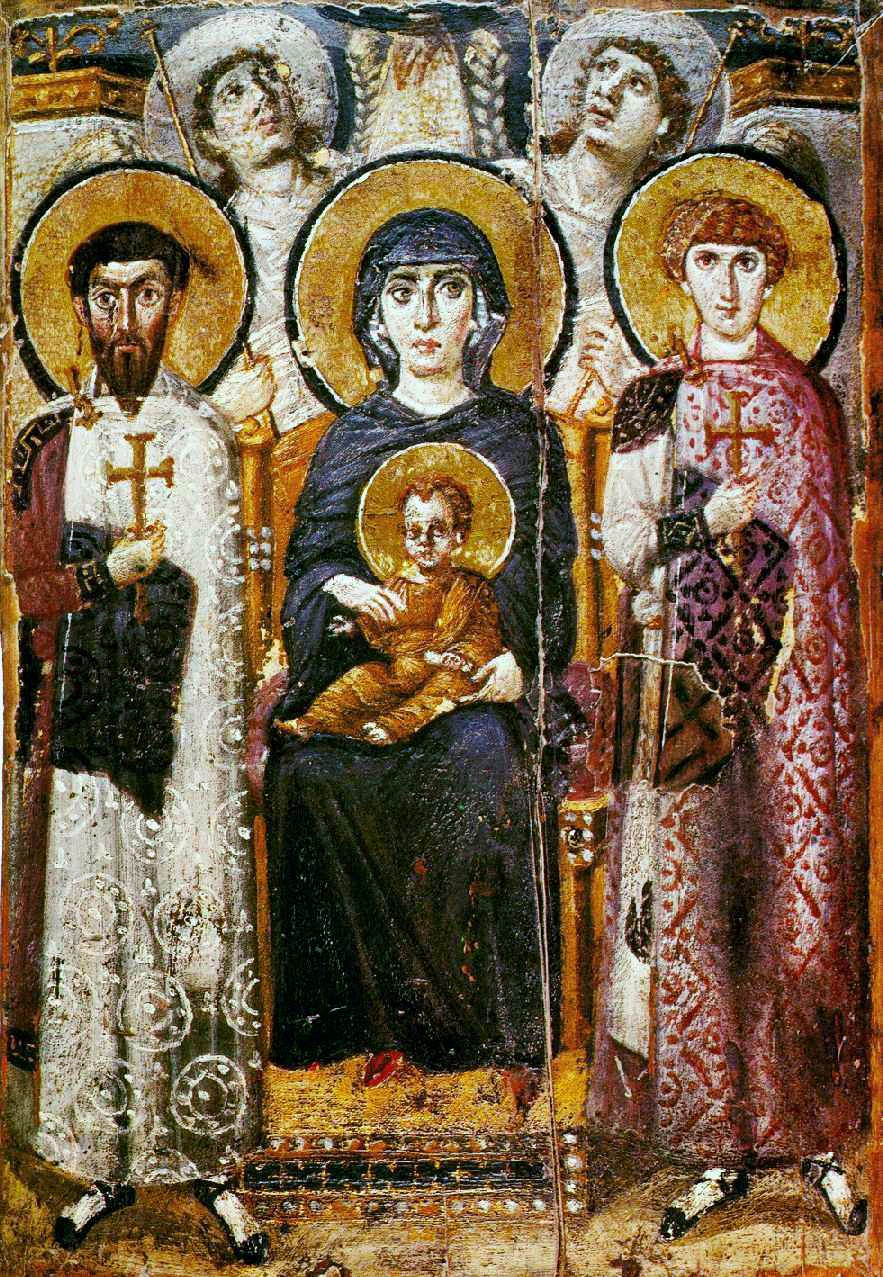
Courtesy of SmartHistory
Form: This is an icon, a religious devotional image. Icons were frequently believed to have spiritual powers and held a fearful place in the hearts of Byzantine worshipers.
Function: Icons are depictions of saints and holy people. These icons were created to foster a deeper sense of spirituality and to assist in channeling the almighty's grace. These objects aided in the conversion of non-Christians while also generating some extra cash for the Byzantine Empire at a time when its coffers were depleted.
Content: The image depicts Mary and the infant Jesus seated between St. Theodore (left) and St. George in the encaustic painting Virgin (Theotokos) and Child between Saints Theodore and George (right). The soldier saints are these two men, each holding a golden cross in his right hand. All four figures have radiant golden halos painted with gold leaf and tiny gold flakes adhered to the painting's surface.
Context: There was an image crisis around the seventh century, primarily as a result of encounters with Arabs and Islam. Previously, icons were treated similarly to relics, as connective tissue to the divine. Iconoclasts, or image breakers, argued, however, that icons were increasingly being worshiped as idols, which contradicted both Jewish and Christian beliefs. Christian officials debated the issue of icons as early as 692, but it would take another 60 years for them to completely banish holy images from churches. While icons were credited with saving Constantinople from a Persian invasion, some officials believed that the loss of certain Byzantine territories to Islamic warriors was divine retribution for failing to observe the Christian faith in the first place. It's a wonder, then, that this encaustic icon survived the iconoclasm era of destruction. Icons made a comeback by 843, but only after much debate about how to create images that could be recognized as just that: images.
Browse Study Guides By Unit
🗿Unit 1 – Global Prehistoric Art, 30,000-500 BCE
🏛Unit 2 – Ancient Mediterranean Art, 3500-300 BCE
⛪️Unit 3 – Early European and Colonial American Art, 200-1750 CE
⚔️Unit 4 – Later European and American Art, 1750-1980 CE
🌽Unit 5 – Indigenous American Art, 1000 BCE-1980 CE
⚱️Unit 6 – African Art, 1100-1980 CE
🕌Unit 7 – West and Central Asian Art, 500 BCE-1980 CE
🛕Unit 8 – South, East, and Southeast Asian Art, 300 BCE-1980 CE
🐚Unit 9: The Pacific, 700–1980 ce
🏢Unit 10 – Global Contemporary Art, 1980 CE to Present
📚Study Tools

Fiveable
Resources
© 2025 Fiveable Inc. All rights reserved.